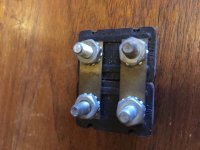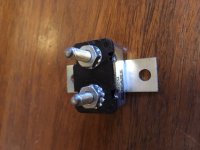RAC68
Darth Vader
Offline
Hi All,
Although I have installed a fair number of in-line fuses to protect almost every internal circuit, I am reconsidering the installation a battery terminal fuse, installed in most modern cars, to protect against a catastrophic short in the direct battery circuit (battery and its main line power lead). Although the fuses installed in most modern vehicles rang from 150 amps to as high as 400 amps, I would expect a much lower amp fuse would be sufficient for my Healey. Since the main purpose is to protect against a catastrophic short, the fuse range I am considering is within the range of 80 amps to 100 amps at maximum.
The installation of a battery terminal fuse would require changing the positive post clamp to one with a upward stud/post for connection to the selected fuse block along with the installation of a ring terminal end on the cable.
Your thoughts and suggestions as to fuse amperage and implementation of changes would be appreciated,
Ray(64BJ8P1)
 OR
OR



Although I have installed a fair number of in-line fuses to protect almost every internal circuit, I am reconsidering the installation a battery terminal fuse, installed in most modern cars, to protect against a catastrophic short in the direct battery circuit (battery and its main line power lead). Although the fuses installed in most modern vehicles rang from 150 amps to as high as 400 amps, I would expect a much lower amp fuse would be sufficient for my Healey. Since the main purpose is to protect against a catastrophic short, the fuse range I am considering is within the range of 80 amps to 100 amps at maximum.
The installation of a battery terminal fuse would require changing the positive post clamp to one with a upward stud/post for connection to the selected fuse block along with the installation of a ring terminal end on the cable.
Your thoughts and suggestions as to fuse amperage and implementation of changes would be appreciated,
Ray(64BJ8P1)





 Hi Guest!
Hi Guest!

 smilie in place of the real @
smilie in place of the real @
 Pretty Please - add it to our Events forum(s) and add to the calendar! >>
Pretty Please - add it to our Events forum(s) and add to the calendar! >> 



